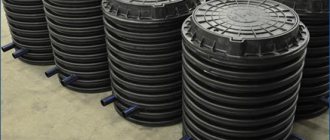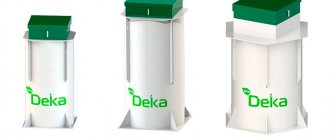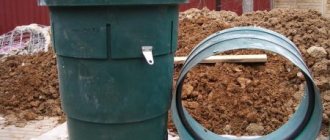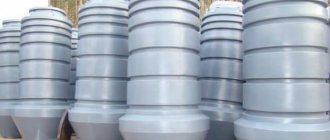A country property is not considered perfect enough for comfortable living if it is not equipped with a system for draining and recycling water used for household needs.
By and large, this is a simple container for sewage in a private house, equipped with a whole set of devices for cleaning wastewater.
The ancestor of such structures is a simple cesspool, the construction of which is prohibited on sites, but they can still be found in operation.
Advantages of plastic compared to other materials
Before the advent of plastic, other materials were used in the construction of sewage systems.
At the domestic level, pipes made of asbestos cement, ceramics and cast iron were used to transport wastewater in the outer part of the sewer system. Asbestos cement is a fragile material and has a short service life under conditions of constant exposure to moisture (soil and internal). Ceramic sewer pipes are a little stronger and last longer, but are more expensive and more difficult to install. Cast iron pipes are expensive, but the worst thing is that at small slope angles they are prone to silting, and if sealing is lost, the external sewage system loses its ability to self-clean, which leads to blockages that are difficult to remove. Plastic pipes do not have these disadvantages.
To collect and partially process wastewater, wells made of reinforced concrete rings, bricks or monolithic concrete were usually installed. Sometimes welded tanks made of steel sheets were used as sewage containers. But all these materials have disadvantages that plastic does not have.
Concrete and metal septic tanks are significantly inferior in characteristics to plastic ones Source avokzal70.ru
A storage tank for sewerage assembled from reinforced concrete rings is still relevant today. Strong, reliable and durable material fully meets the requirements that are placed on it. Provided that the manufacturer produces rings without violating technology. Concrete is a “capricious” material - low-quality ingredients (for example, expired cement, quarry sand mixed with clay) or skimping on additives can significantly reduce the service life of a sewer well. The “weakest” link is the joints of the rings with each other and with the bottom. And in order for them to remain airtight, it is necessary to carry out reliable waterproofing. And the main disadvantage is that a storage tank or septic tank made of reinforced concrete rings is expensive, even when the volume of wastewater is small.
A brick storage tank is now not considered at all and as a cesspool. The high hygroscopicity of the material, even with external waterproofing with rolled materials, leads to rapid destruction and loss of tightness.
A brick septic tank is the lot of self-construction - impractical and ineffective, in comparison with a plastic container for sewerage in a country house Source rinnipool.ru
See also: Catalog of companies that specialize in installation and design of sewerage and water supply
In terms of production time and costs, a container made of monolithic concrete is similar to a small permanent pool without finishing. Such a structure is then very difficult to dismantle if there is a need to modernize the autonomous sewer system or redevelop the site.
A tank made of ordinary steel will not last long in conditions of high humidity and aggressive environments, and is more expensive than a plastic one. And using a stainless steel container is expensive and impractical.
A plastic container for a septic tank and wastewater storage tank does not have the above disadvantages. Its advantages:
- affordable price;
- inertness towards any type of domestic waste;
- absolute tightness;
- environmental Safety;
- high bending and tensile strength;
- light weight (simplifies transportation and installation);
- long service life.
The only drawback is the need to rigidly fix the container in the pit (for example, to a concrete slab at the base) and take measures to reduce the impact of heaving forces. This must be done so that the container does not “float” to the surface.
The plastic septic tank is fixed on a concrete slab or on reliable guy wires Source skopelitissa.com
Only peat bogs and the humus (fertile) layer have a low density (1150-1200 kg/m3), and the lightest loams and sandy loams (1600-1700 kg/m3) are much heavier than a plastic tank with wastewater. Therefore, heaving forces will tend to push it to the surface.
Advantages of polypropylene storage devices
The unique properties of polypropylene make it possible to use it for the production of sanitary containers for cesspools . Products made from this polymer have:
- high strength;
- resistance to impacts, bending;
- increased wear resistance;
- resistance to acids, solvents, alkalis;
- water resistance;
- resistance to temperature changes, high (up to +120-140°C) temperatures;
- good weldability, welding seams are sufficiently strong.
Among the disadvantages of polypropylene containers for sewage waste is their low frost resistance and flammability. For these reasons, tanks must be placed in pits and covered with a small layer of soil.
Types of sewage containers
There are three main schemes for constructing an autonomous sewer system. In each of them, the plastic container performs its task and differs in its internal structure.
Storage capacity
In function, this is a typical storage sewer. Refers to the simplest and most affordable scheme. The container does not have internal partitions, and its task is to collect household wastewater for subsequent pumping with a sewage disposal machine.
Inside, only natural processes of waste decomposition occur without separation into fractions and wastewater treatment. The frequency of calling vacuum cleaners depends on the intensity of use, and this is the main drawback that determines the scope of use - summer cottages, small country houses for seasonal residence.
The storage septic tank simply collects wastewater, which is then pumped out by a sewer truck Source gorobzor.ru
What are the disadvantages of storage tanks?
- Only the initial costs of installing the tank will be small. You must be prepared for the constant costs of disposing of sewage using a sewage disposal machine. The cost of calling such a car in the Moscow region ranges from 1500-2000 rubles. depending on the area.
- Storage tanks made of plastic must be anchored to a reinforced concrete slab in an area with a high groundwater level (GWL).
Features of installation and operation of sewer tanks
When choosing a place to install a container, it is necessary to take into account the gravity drainage of wastewater - if the site is located on a slope, then it should be located below the level of the house.
The bottom of the pit must be smooth and strong, preventing the possibility of the container moving so that the tightness of the connection with the sewer pipe is not compromised.
To anchor the container, use a reinforced concrete slab laid at the bottom of the pit with the obligatory arrangement of a cushion of crushed stone and sand.
To reduce the buoyancy forces of heaving, a pit is dug larger than the dimensions of the container, and the sinuses are filled with a mixture of sand and excavated soil or sand and crushed stone.
Rules for choosing a barrel
In order for sewage from the toilet, sink, shower and bath to be disposed of in its entirety, the drainage barrel for the drain must be selected in accordance with the following series of criteria:
- Total volume of waste. In this case, the maximum possible amount of drainage should be taken into account both at one time and during the day with the use of all plumbing fixtures installed and connected in the house.
- The nature of the operation of the sewer system - frequency, periodicity, seasonality.
- The type of soil at the site where the drain tank is dug in, its hydrogeological parameters, as well as the level of soil water.
- The financial amount that is planned to be spent on the project.
In most cases, a plastic or steel barrel is best suited for organizing drainage.
Septic tank made of polyethylene
They are made from low-density polyethylene using the rotational molding method, due to which they are immediately seamless. Polyethylene of the LLDPE modification is environmentally friendly and is resistant to aggressive environments and chemical pollution.
It should be noted that during rotational molding, the product may have unequal wall thickness, which can negatively affect the performance properties of the septic tank. In addition, polyethylene has low strength, i.e. In order to avoid damage to the walls of the housing, you must be extremely careful when backfilling the polyethylene septic tank with uncleaned sand.
Price for septic tanks
The cost of a turnkey septic tank consists of the price of the product, the cost of installation, the cost of wastewater treatment and subsequent maintenance. For example, let’s take buildings designed for 3 people (with a productivity of 0.6 m³ per day). We get 4 price categories:
30,000 rubles
Construction of a septic tank from three concrete rings will cost you an average of 30 thousand rubles. Their installation will require the use of a crane and free space on the site.
The prefabricated structure does not guarantee complete tightness of the containers - it is possible for untreated wastewater to seep into the ground and fill the septic tank with groundwater. Additional costs will be required for the purchase and installation of plastic sealed inserts.
Installation requires additional costs for the rental of special equipment and the purchase of waterproofing materials. Installation time is 2-3 days.
45,000 rubles
An overflow, non-volatile septic tank made of polyethylene with three compartments costs from 45 thousand rubles without taking into account the arrangement of drainage systems that require additional treatment of clarified wastewater.
Once a year it is necessary to remove sedimentary contaminants using a sewer truck. No special equipment is needed during installation; installation time is 1 day.
60,000 rubles
A local sewerage station made of polypropylene with three compartments, a pump and a biofilter will cost from 60 thousand rubles. Electricity is required to power the recirculation pump. A timer for pump operation is included.
Due to the high degree of biological decomposition of coarse contaminants, sludge removal can be carried out every 2 years. The pumped-out sludge can be stored in a compost pit and, after fermentation, used as fertilizer. No special equipment is required for installation; installation time is 1 day.
70,000 rubles
The aeration unit is made of corrosion-resistant monolithic sheet polypropylene and is the most effective treatment facility providing deep biological treatment of domestic wastewater.
It is equipped with an aeration compressor and airlifts for supplying wastewater to the aeration tank and removing sludge from the settling tank; there are modifications with an additional biofilter. Requires electricity supply. Cost - from 70 thousand rubles. Maintenance: once a year, clean the airlifts and compressor filters, once every 2 years, pump out solid sediment with a fecal pump or a sewer truck.
Article: 2230845-276
Eurolos PRO 5+
Aeration biological treatment plant
- Capacity 1 m³ per day
- Purifies up to 1000 liters of wastewater per day
105,800
rubles
Price of septic tank
Article: 2230845-274
Eurolos PRO 4+
Aeration biological treatment plant
- Capacity 0.8 m³ per day
- Cleans up to 800 liters of wastewater per day
99900
rubles
Price of septic tank
Article: 2230845-271
Eurolos PRO 3
Aeration biological treatment plant
- Capacity 0.6 m³ per day
- Cleans up to 600 liters of wastewater per day
86,500
rubles
Price of septic tank
Article: 2230843-182
Eurolos BIO 4+
Local wastewater treatment plant
- Capacity 0.8 m³ per day
- Cleans up to 800 liters of wastewater per day
91,500
rubles
Price of septic tank
Article: 2270390-1111
Eurolos GRUNT 3+
Autonomous sewerage system for high groundwater level
- Capacity 0.6 m³ per day
- Cleans up to 600 liters of wastewater per day
124,400
rubles
Price of septic tank
Article: 2270390-1113
Eurolos GRUNT 4+
Autonomous sewerage system for high groundwater level
- Capacity 0.8 m³ per day
- Cleans up to 800 liters of wastewater per day
131900
rubles
Price of septic tank
Article: 2270390-1114
Eurolos GRUN 5
Autonomous sewerage system for high groundwater level
- Capacity 1 m³ per day
- Purifies up to 1000 liters of wastewater per day
137,600
rubles
Price of septic tank
Article: 2230843-180
Eurolos BIO 3+
Local wastewater treatment plant
- Capacity 0.6 m³ per day
- Cleans up to 600 liters of wastewater per day
88,700
rubles
Price of septic tank











